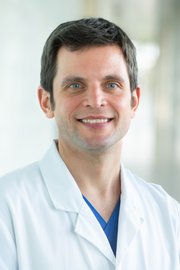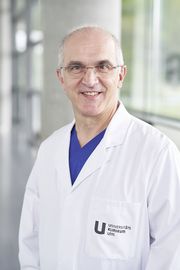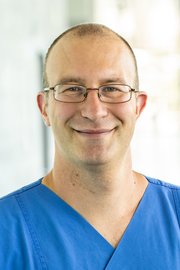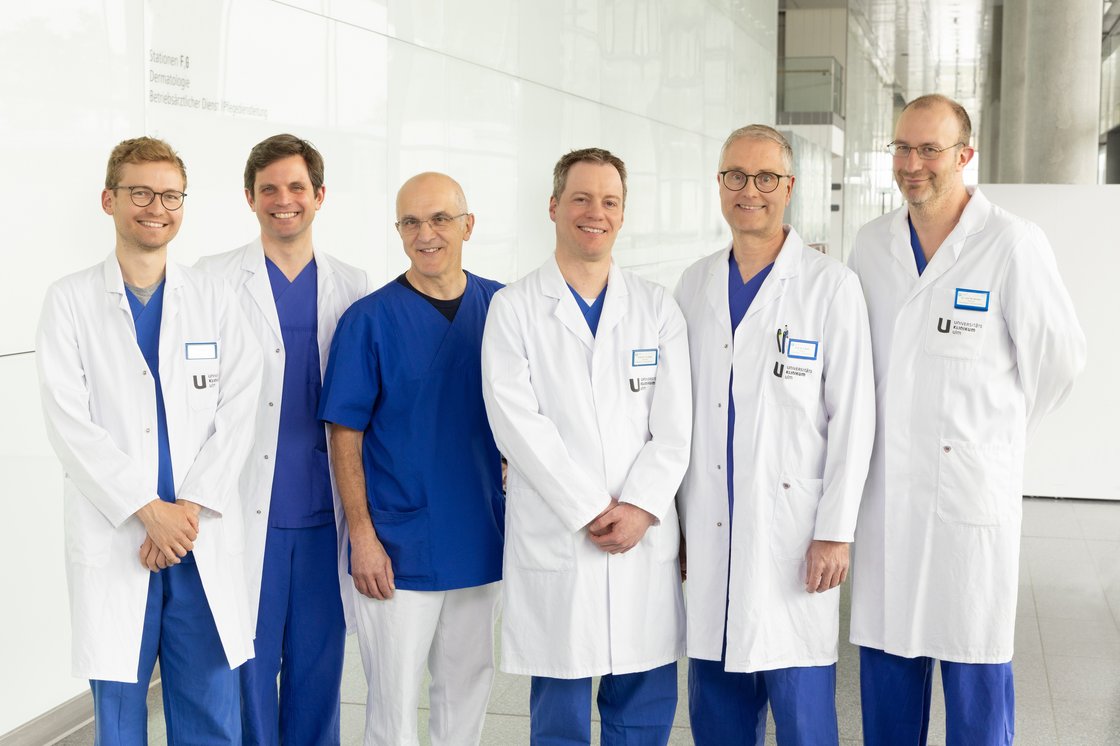Our profile
We treat patients from all surgical clinics on a total of 39 beds:
- Visceral surgery
- Cardiac, thoracic and vascular surgery
- Trauma and reconstructive surgery
- Neurosurgery
- Paediatric neurosurgery
The ICU area focuses on the intensive medical care of patients with life-threatening multiple injuries (polytrauma), patients with organ failure and patients with lung failure in acute respiratory distress syndrome (ARDS).
Patients from other areas such as haemato-oncology and cardiology are also cared for.
Furthermore, we are responsible for the perioperative care of patients with relevant pre-existing conditions and/or major surgical interventions from the above-mentioned clinics.
A training and research focus is on diagnostic emergency sonography and the performance of ultrasound-guided punctures.
Regular communication with the next of kin is very important to us.
Please appoint within the family a contact person for the medical team.
Telephone information:
Between 10:30 and 11:30 and by appointment on 0731 500-60055
We would like to point out that only the next of kin can receive telephone information from the attending physicians.
Contact:
Albert-Einstein-Allee 23 | 89081 Ulm
T +49 731 500-60055 | F +49 731 500-60052
ioi.ains@uniklinik-ulm.de
We kindly ask you to avoid calling during visiting hours:
- 07:30 - 09:00
- 13:00 - 15:00
- 18:45 - 20:30
Visiting hours: 15:00 - 18:30 and by prior appointment.
Please note the current visitor regulations on our homepage:
https://www.uniklinik-ulm.de/aktuelles/informationen-und-hinweise-zum-coronavirus.html
Thank you for your understanding!
Our team

Prof. Dr. med. Eberhard Barth
Leitung IOI, Oberarzt, Facharzt für Anästhesiologie, Zusatzbezeichnungen: Notfallmedizin, spezielle Intensivmedizin, spezielle Schmerztherapie

Dr. med. Nicolai Andrees
Stellv. Leitung IOI, Oberarzt, Facharzt für Anästhesiologie, ärztliches Qualitätsmanagement, Zusatzbezeichnung: spezielle Intensivmedizin
Schwerpunkte
Teleintensivmedizin

Prof. Dr. med. Karl Träger
Oberarzt, Facharzt für Anästhesiologie, Zusatzbezeichnungen: Notfallmedizin, leitender Notarzt, spezielle Intensivmedizin, European Diploma in Anaesthesiology and Intensive Care, Transplant.-Beauftr., Hygiene-Beauftr.

Dr. med. Max Neubert
Oberarzt, Facharzt für Anästhesiologie, Zusatzbezeichnungen: Notfallmedizin, spezielle Intensivmedizin
In addition, a team of 4-5 specialists as well as 7 anaesthesiological and 4 surgical residents in further training work in a 3-shift model in the anaesthesiological intensive care unit. The department has full further training for the additional qualification "Special Intensive Care Medicine".
Ward secretariat
Patients can be registered and certificates requested via the ward secretariat. The secretariat also coordinates the transfer of our patients to normal wards or rehabilitation facilities. A nursing assistant looks after the sensitive area of ordering, documenting and stocking medication.
Susanne Hengsteler
Lisa Becker
Sharon Mürner-Kässmeyer
| Office hours | 08:00 - 15:00 |
| Tel: | 0731 500-60055 |
| E-Mail: |
Physiotherapy, occupational therapy
A team from the physiotherapy department cares for all patients in the ICU and IMC area on a daily basis. In addition to respiratory therapy exercises, early mobilisation is the focus of the activities. Lymphatic drainage, swallowing training and occupational therapy are also available for special indications.
Approach
Please follow first ...
... the
maps and the directions on the homepage of the University Hospital
to the bus stop "Kliniken Wissenschaftsstadt" or to the car park "Mitte".
Once you have reached the "Kliniken Wissenschaftsstadt" stop or the "Mitte" multi-storey car park ...
... you will reach the main entrance of the surgical clinic after a short walk.
The porter in the Surgical Clinic will be happy to help you find your way to the relevant anaesthesia rooms:
- Interdisciplinary ICU/IMC ward G1 in the area of the lifts G level 1 of the Surgical Clinic
- Interdisciplinary ICU/IMC ward F1 in the area of the lifts F level 1 of the surgical clinic
- Management and secretarial offices in the lift area F Level 2 of the Surgical Clinic

Lungenersatz (ECMO)
24-Stunden-Hotline:
Telefon: 0731 500-60308
Telefax: 0731 500-60052
Was ist invasiver Lungenersatz (ECMO-Therapie)?
Bei manchen Krankheiten kann der Gasaustausch eingeschränkt sein, so dass Kohlendioxid nicht mehr ausreichend abgegeben oder/und Sauerstoff nicht mehr ausreichend aufgenommen wird. Beides kann zu einem Iebensbedrohlichen Zustand führen.
Durch maschinelle Beatmung und Anreicherung der Atemluft mit zusätzlichem Sauerstoff kann eine solche Situation häufig beherrscht werden. Allerdings können durch hohe Beatmungsdrücke und hohe Sauerstoffkonzentrationen weitere Schäden an der Lunge entstehen, die wiederum den Gasaustausch einschränken. Auf diese Weise entsteht eine Spirale, die im schlimmsten Fall dazu führen kann, dass trotz eskalierter maschineller Beatmung die Kohlendioxidabgabe oder die Sauerstoffaufnahme nicht mehr ausreichend kontrolliert werden können. Dieser Zustand ist absolut lebensbedrohlich.
Eine häufige Ursache ist das Akute Atemnotsyndrom des Erwachsenen (ARDS), das nach Operationen oder Infektionen der Lunge oder des übrigen Organismus auftreten kann. Eine andere Ursache sind strukturelle Lungenerkrankungen wie zum Beispiel die Lungenfibrose.
Invasiver Lungenersatz kann in diesen Fällen eine therapeutische Option darstellen. ECMO ist der Gebrauch einer Form der Herz-Lungen-Maschine bei Patienten, deren Herz- oder Lungenversagen trotz Einsatz maximaler Therapie nicht aufzuhalten ist und bei ihrer Fortführung in relativ kurzer Zeit wahrscheinlich den Tod des Patienten bedeuten würde. Die ECMO wird über große Blutgefäße (meist am Hals und in der Leiste) an den Kreislauf des Patienten angeschlossen und übernimmt die Funktion der Lunge (veno-venöse ECMO) — in manchen Fällen auch die des Herzens (veno- arterielle ECMO) — solange, bis sich die Organe soweit erholt haben, dass eine konventionelle Behandlung der Grundkrankheit wieder möglich ist. Die Dauer der erforderlichen ECMO-Behandlung kann von wenigen Tagen bis zu mehreren Wochen betragen. Zur Kreislaufüberwachung sowie zur begleitenden medikamentösen Therapie und zur künstlichen Ernährung sind zusätzliche arterielle und venöse Zugänge erforderlich, wie sie auch bei der konventionellen Intensivtherapie schwerst kranker Patienten zur Anwendung kommen. Im Rahmen der ECMO-Therapie kommt es darüber hinaus zur Notwendigkeit wiederholter Laboruntersuchungen (Blut und Urinproben) und Röntgenaufnahmen.
Gleichzeitig kann sich durch schonende Beatmung der Lunge und durch Behandlung der Grundkrankheit die Lunge des Patienten erholen. Wenn die Lunge unumkehrbar geschädigt und der Patient für eine Lungentransplantation geeignet ist, kann durch invasiven Lungenersatz die Zeit bis zu einer Organzuteilung überbrückt werden.
Ein invasives Lungenersatzverfahren ist also eine Brückentherapie für einige Tage bis wenige Wochen, das nur dann sinnvoll ist, wenn die Lunge entweder nicht unumkehrbar geschädigt ist, oder wenn der Patient bei dauerhafter Lungenschädigung für eine Lungentransplantation in Frage kommt.